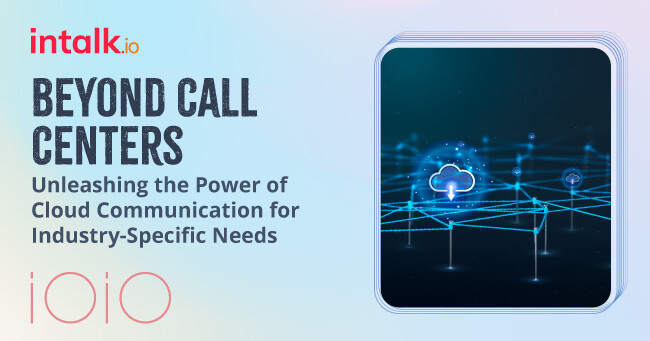The traditional call center has long been the backbone of customer interaction for many businesses. However, in today’s dynamic and digitally driven world, its limitations are becoming increasingly apparent. Enter cloud communications: a revolutionary approach that offers adaptability, versatility, and a level of customization that traditional systems simply can’t match.
This blog will explore how cloud communication empowers businesses across four key industries – healthcare, finance, retail, and education – to move beyond the one-size-fits-all model and tailor their customer interactions for improved efficiency, satisfaction, and overall outcomes.
Limitations of Traditional Call Centers and the Rise of Cloud Communication
Traditional call centers, while serving their purpose initially, struggle to keep pace with the evolving needs of customers and businesses alike. Here are some key shortcomings:
Limited Scalability: Traditional setups often involve expensive on-premise infrastructure that can be difficult and costly to scale up or down as business needs fluctuate.
Inflexibility: Rigid systems offer limited options for integrating new communication channels like video calls or SMS, hindering the ability to adapt to changing customer preferences.
Data Silos & Limited Analytics: On-premise solutions often create data silos, making it difficult to get a holistic view of customer interactions. This limits the ability to extract meaningful insights and optimize communication strategies.
High Maintenance Costs: Upkeep of on-premise hardware and software can be expensive and time-consuming, diverting resources from core business activities.
Cloud communication platforms break free from these shackles. By leveraging the power of the cloud, they offer a plethora of advantages:
Scalability on Demand: Cloud-based systems are inherently scalable, easily adapting to accommodate growing customer interactions or sudden surges in demand.
Enhanced Flexibility: Cloud platforms integrate seamlessly with various communication channels like voice, video, chat, and SMS, enabling businesses to offer a multi-channel experience that caters to diverse customer preferences.
Unified Data & Advanced Analytics: Cloud solutions consolidate customer interaction data from various channels into a central repository. This allows for in-depth analysis to identify trends and optimize communication strategies for better outcomes.
Cost-Effectiveness: With cloud-based subscriptions, businesses eliminate the need for upfront infrastructure investments, reducing overall communication costs. Additionally, automatic updates and maintenance ensure businesses have access to the latest features without further investment.
Industry-Specific Needs: Why a One-Size-Fits-All Doesn’t Work
Now let’s delve into the diverse communication needs of four key industries:
Healthcare: Here, building trust and ensuring a seamless patient experience is paramount. Cloud communication facilitates secure two-way communication between patients, doctors, and healthcare providers. Features like appointment reminders, telehealth consultations, and secure messaging optimize patient care and streamline communication workflows.
Finance: Security and compliance are critical in the finance sector. Cloud communication platforms offer robust features like multi-factor authentication and encryption to safeguard sensitive customer information. Additionally, cloud-based collaboration tools enable seamless communication between internal teams, ensuring efficient financial operations.
Retail: Customer engagement and personalized experiences are key drivers of success in retail. Cloud communication allows retailers to integrate chatbots, in-app messaging, and targeted SMS campaigns for personalized marketing and customer support. Additionally, features like click-to-call functionality enhance customer convenience and bridge the gap between online and offline interactions.
Education: Effective communication between educators, students, and parents is crucial in today’s learning environment. Cloud solutions facilitate remote learning through video conferencing and online collaboration tools. Additionally, secure messaging allows for timely updates and two-way communication between educators and parents, fostering collaboration in the learning process.
Tailored Communication with Cloud Solutions
A one-size-fits-all approach fails to address the unique communication requirements of these industries. Cloud communication empowers businesses to tailor their interaction strategies based on these specific needs:
Customization: Businesses can cherry-pick functionalities that best suit their industry. For example, healthcare providers can prioritize secure messaging options, while retailers might focus on integrating chatbots for personalized marketing.
Integration with Existing Systems: Cloud platforms integrate seamlessly with existing CRM and business management software, allowing for a unified communication experience within a familiar business ecosystem.
Improved Customer Experience: By catering to diverse communication preferences and offering real-time, secure interaction channels, cloud solutions elevate the overall customer experience.
Data-Driven Decision Making: In-depth analytics provided by cloud platforms empower businesses to gain valuable insights into customer interactions. This data can be used to optimize communication strategies, improve agent performance, and ultimately, lead to better customer outcomes.
Conclusion: Embracing the Future of Communication
As businesses continue to adapt and evolve, their communication strategies need to follow suit. Cloud communication offers a future-proof solution with its inherent scalability, flexibility, and data-driven insights. By embracing cloud-based platforms and tailoring their communication





